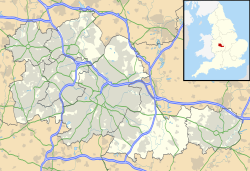History
The building was designed as the headquarters of the 3rd Staffordshire Rifle Volunteer Corps and was completed in 1866. [1] This unit evolved to become the 2nd Volunteer Battalion, the South Staffordshire Regiment in 1885 and the 5th Battalion, the South Staffordshire Regiment in 1908. [2] The drill hall was substantially remodelled in 1910. [1] The battalion was mobilised at the drill hall in August 1914 before being deployed to the Western Front. [3]
The presence at the drill hall was reduced to a single company, B (South Stafford) Company, 5th/6th (Territorial) Battalion, The Staffordshire Regiment (The Prince of Wales's), in 1967 which evolved to become D Company, 2nd Battalion, Mercian Volunteers in 1975. [4] After the battalion left the drill hall in 1984, it was decommissioned and subsequently converted for use as a nightclub. [5]
This page is based on this
Wikipedia article Text is available under the
CC BY-SA 4.0 license; additional terms may apply.
Images, videos and audio are available under their respective licenses.

